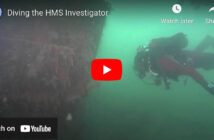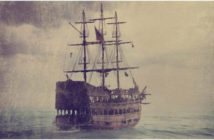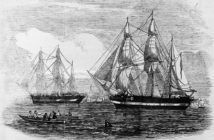The Northwest Passage through the Arctic was discovered long ago, but the ownership of Arctic Ocean beds remains unsolved. Canada, Norway, Russia, the United States and Denmark have all filed claims. Denmark’s claim is through its connection with Greenland.
In 1845 Sir John Franklin, a captain in Britain’s navy, led a mission of two ships in an attempt to complete a yet un-navigated portion of the Northwest Passage that would provide a shortcut for ships between the northern Atlantic and Pacific oceans. However, some dispute that this was Franklin’s purpose, arguing it was impossible to navigate it in a single season then. Instead, they believe his mission was to conduct studies of the Magnetic North Pole.
This shortcut will eventually be helpful for commerce and other uses. Today, the stakes are much higher because it is now known there is oil in the Arctic. Furthermore, with climate change warming the Arctic region at a much faster rate than other areas, sea ice is melting in tandem. This means there will be more weeks when the Northwest Passage can be navigated, thus enhancing water transport.
An aggressive move by the Russians and the discovery of Franklin’s ships within the last 10 years brought the issue front and centre for Canadians. In 2007, a team of six Russians using submersibles went down to the ocean bottom at the North Pole. They placed a Russian flag on the seabed and took soil samples to back their argument there were minerals there. Russia also wanted to establish that the Lomonosov Ridge close to the North Pole was an extension of its land mass. In 2014 a Canadian team located HMS Erebus west of O’Reilly Island in the Arctic. The HMS Terror, the other Franklin ship, was discovered by the Arctic Research Foundation south of King William Island. It was in good condition.
Franklin’s “lost expedition” of Arctic exploration ended in disaster. No one survived. A Royal Navy captain, he was a veteran of three previous expeditions to the Arctic, two of them as commanding officer. When the voyage began in 1845 Franklin was 59 and some believed his health was not well enough to face the challenges.
A few of his crew members died early but when both ships became icebound in Victoria Strait the fate of the others was sealed. They faced a worse death. All 129 men died, including the captain. They succumbed to starvation, hypothermia, scurvy and exposure. They did not have proper clothing for the extreme cold they faced, nor did they have proper nutrition.
Nevertheless, Franklin remained a hero in the British press. Songs, short stories and, much later, television documentaries about him were produced. Statues of Franklin were built. He was credited with discovering the Northwest Passage. Actually, it was found by John Rae. Rae also picked up relics and information about the Franklin expedition from the Inuit, while exploring the Arctic coast south of King William Island in 1854.
Directed by Ben Finney and produced by Andrew Gregg for CBC’s Nature of Things.
YouTube 2015








